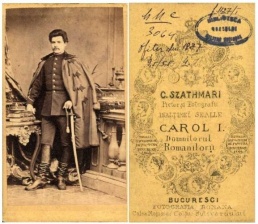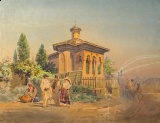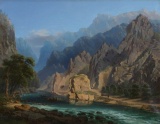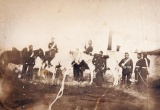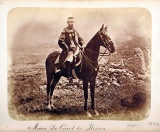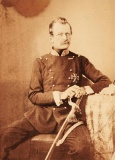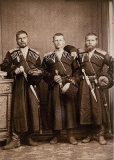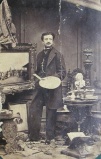Difference between revisions of "Carol Szathmari"
Sorindanut (talk | contribs) |
|||
| Line 1: | Line 1: | ||
| − | [[ | + | {{Infobox artist |
| − | '''Carol Szathmari''' ( | + | |image = Caroll pop.JPG |
| + | |imagesize = 250px | ||
| + | |caption=Self-portrait. | ||
| + | |birth_date = {{birth date|1812|1|11|mf=y}} | ||
| + | |birth_place = Cluj, Grand Principality of Transylvania, Austrian Empire | ||
| + | |death_date = {{Death date and age|1887|6|3|1812|1|11|mf=y}} | ||
| + | |death_place = [[Bucharest]], [[Romania]] | ||
| + | }} | ||
| + | [[Image:Fotografie-carte de vizita a lui carol popp de szathmari.jpg |thumb|258px|CDV photo by Szathmari]] | ||
| + | '''Carol Szathmari''' (Romanian: Carol Popp de Szathmary, Hungarian: Szathmáry Pap Károly, 1812-1887) was a painter, lithographer and photographer. | ||
| − | + | == Early life== | |
| + | Before developing his inclination for photography, he studied painting and engraving, two popular arts of that period.<ref>{{harvnb|Bumbuţ|2009-2010|p=81}}</ref> | ||
| − | + | His talent for painting shone out from an early age. Being a passionate traveller, Szathmari journeyed through Europe and often crossed the Carpathian Mountains to visit Wallachia and its capital Bucharest, where he eventually settled in 1843. An accomplished landscape and portrait painter, at ease with both watercolours and oil paints, Szathmari obtained commissions from the wealthy Wallachian boyars. Szathmari kept up constant, good relations with the successive ruling princes of Wallachia for whom he painted portraits and various other compositions.<ref>{{harvnb|Ionescu|2013}}</ref> | |
| − | + | == The Crimean War== | |
| − | He | + | In 1848, Szathmari began to experiment with photography. The outbreak of the Russian-Ottoman War in late June 1853 saw the Romanian principalities occupied by the Russian army. In April 1854, Szathmari filled a van with his cameras and glass plates and went to the border of the Danube to document the fighting between the Russian and Turkish armies.<ref>{{harvnb|Ionescu|2013}}</ref> |
| + | |||
| + | This made him one of the first combat photographers in the battlefield (there were also Roger Fenton, William Russell, and [[Ludwig Angerer#Amateur_photographer_during_Crimean_War|Ludwig Angerer]] photographing the Crimean War). | ||
| + | |||
| + | The result of Szathmari's bravery and hard work was a photographic album. His album, containing some two hundred images, became famous due to its presentation at the 1855 Paris World Exhibition and Szathmari was awarded the Second Class Medal for his work. From that time on, photography, painting and lithography were always closely connected in Szathmari's career.<ref>{{harvnb|Ionescu|2013}}</ref> | ||
| + | |||
| + | == Court photographer== | ||
| + | In 1864 he became member of the Société Française de Photographie in Paris and in 1870 of the one in Vienna. In 1863, he received the title of Ruling Prince (Alexandru Ioan Cuza)'s Court Painter and Photographer which he kept for the rest of his life. The official painter followed his patron, Prince Carol I, on the battlefield during the Russian-Romanian-Ottoman War of 1877, which was waged south of the Danube.<ref>{{harvnb|Ionescu|2013}}</ref> | ||
| + | |||
| + | He was the first certified photographer in Romania, being also one of the first ten photographers in Europe. | ||
| + | |||
| + | == Other work== | ||
| + | Along martial compositions and albums, Szathmari had long been attracted by folk types and produced a large series of pictures with peasants, gypsies, postillions, merchants and artisans. He toured the fairs and the crowded streets of the town in search of picturesque types.<ref>{{harvnb|Ionescu|2013}}</ref> | ||
| + | |||
| + | He also chronicled art photography in Romania. His article entitled "Photographie Parisienne" appeared in the Viennese magazine ''Photographische Correspondenz'' in 1865.[http://www.scribd.com/doc/109441096/istoria-fotografiei-articol-revista-istorica] | ||
| + | |||
| + | The artist's last major work was the chromolithographic album of the symbolic carts which paraded the Capital city on 10-11 May 1881, King Carol's coronation pageant.<ref>{{harvnb|Ionescu|2013}}</ref> | ||
| + | |||
| + | Most of his life he worked and lived in [[Bucharest]], where he died. | ||
==Paintings== | ==Paintings== | ||
| Line 15: | Line 43: | ||
Carol Târgul Moşilor, ulei pe pânză, 1861.jpg|Târgul Moşilor, oil on canvas, 1861, oil | Carol Târgul Moşilor, ulei pe pânză, 1861.jpg|Târgul Moşilor, oil on canvas, 1861, oil | ||
</gallery> | </gallery> | ||
| − | |||
| − | |||
| − | |||
==Photographs== | ==Photographs== | ||
| Line 36: | Line 61: | ||
==Notes== | ==Notes== | ||
| − | {{Reflist|1}} | + | {{Reflist|3}} |
| + | |||
| + | ==Literature== | ||
| + | * {{cite journal|ref=harv|last=Bumbuţ|first=Cosmin|title=Carol Szathmari: Partea I|journal=[http://issuu.com/punctum/docs/punctum1 Punctum]|number=1|year=2009-2010|pages=78–?|language=Romanian}} | ||
| + | * {{cite journal|ref=harv|last=Ionescu|first=Adrian-Silvan|title=[http://www.riha-journal.org/articles/2013/2013-apr-jun/ionescu-szathmari Szathmári, un mare artist documentarist]|journal=RIHA Journal|number=70|day=24|month=April|year=2013|language=Romanian}} With English abstract. | ||
| − | + | ==See also== | |
* [[Romania#Photography]] | * [[Romania#Photography]] | ||
* [[Hungary#Photography]] | * [[Hungary#Photography]] | ||
| − | + | ==External links== | |
* [http://en.wikipedia.org/wiki/Carol_Szathmari Szathmari at Wikipedia] | * [http://en.wikipedia.org/wiki/Carol_Szathmari Szathmari at Wikipedia] | ||
* [http://ro.wikipedia.org/wiki/Carol_Popp_de_Szathm%C3%A1ri Szathmari at Romanian Wikipedia] | * [http://ro.wikipedia.org/wiki/Carol_Popp_de_Szathm%C3%A1ri Szathmari at Romanian Wikipedia] | ||
Revision as of 18:32, 12 June 2013
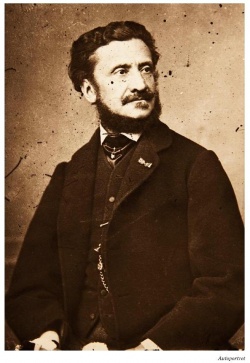 Self-portrait. | |
| Born |
January 11, 1812 Cluj, Grand Principality of Transylvania, Austrian Empire |
|---|---|
| Died |
June 3, 1887 (aged 75) Bucharest, Romania |
Carol Szathmari (Romanian: Carol Popp de Szathmary, Hungarian: Szathmáry Pap Károly, 1812-1887) was a painter, lithographer and photographer.
Contents
Early life
Before developing his inclination for photography, he studied painting and engraving, two popular arts of that period.[1]
His talent for painting shone out from an early age. Being a passionate traveller, Szathmari journeyed through Europe and often crossed the Carpathian Mountains to visit Wallachia and its capital Bucharest, where he eventually settled in 1843. An accomplished landscape and portrait painter, at ease with both watercolours and oil paints, Szathmari obtained commissions from the wealthy Wallachian boyars. Szathmari kept up constant, good relations with the successive ruling princes of Wallachia for whom he painted portraits and various other compositions.[2]
The Crimean War
In 1848, Szathmari began to experiment with photography. The outbreak of the Russian-Ottoman War in late June 1853 saw the Romanian principalities occupied by the Russian army. In April 1854, Szathmari filled a van with his cameras and glass plates and went to the border of the Danube to document the fighting between the Russian and Turkish armies.[3]
This made him one of the first combat photographers in the battlefield (there were also Roger Fenton, William Russell, and Ludwig Angerer photographing the Crimean War).
The result of Szathmari's bravery and hard work was a photographic album. His album, containing some two hundred images, became famous due to its presentation at the 1855 Paris World Exhibition and Szathmari was awarded the Second Class Medal for his work. From that time on, photography, painting and lithography were always closely connected in Szathmari's career.[4]
Court photographer
In 1864 he became member of the Société Française de Photographie in Paris and in 1870 of the one in Vienna. In 1863, he received the title of Ruling Prince (Alexandru Ioan Cuza)'s Court Painter and Photographer which he kept for the rest of his life. The official painter followed his patron, Prince Carol I, on the battlefield during the Russian-Romanian-Ottoman War of 1877, which was waged south of the Danube.[5]
He was the first certified photographer in Romania, being also one of the first ten photographers in Europe.
Other work
Along martial compositions and albums, Szathmari had long been attracted by folk types and produced a large series of pictures with peasants, gypsies, postillions, merchants and artisans. He toured the fairs and the crowded streets of the town in search of picturesque types.[6]
He also chronicled art photography in Romania. His article entitled "Photographie Parisienne" appeared in the Viennese magazine Photographische Correspondenz in 1865.[1]
The artist's last major work was the chromolithographic album of the symbolic carts which paraded the Capital city on 10-11 May 1881, King Carol's coronation pageant.[7]
Most of his life he worked and lived in Bucharest, where he died.
Paintings
Photographs
Notes
Literature
- Bumbuţ, Cosmin (2009-2010). "Carol Szathmari: Partea I". Punctum (1): 78–? (Romanian).
- Ionescu, Adrian-Silvan (24 April 2013). "Szathmári, un mare artist documentarist". RIHA Journal (70) (Romanian). With English abstract.
